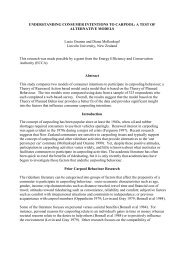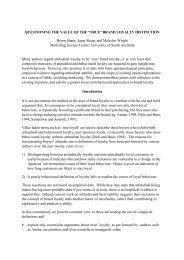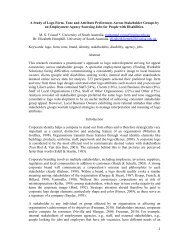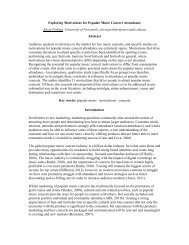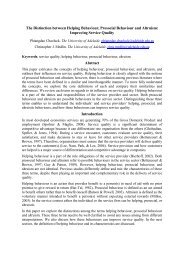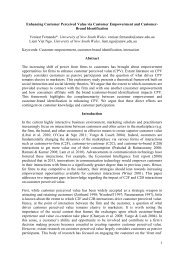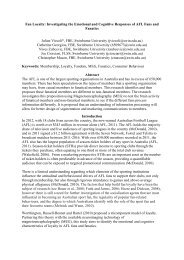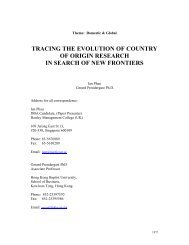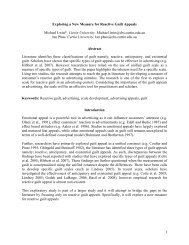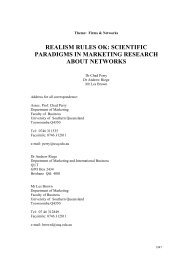1 CO-CREATION: A TYPOLOGY AND CONCEPTUAL ... - ANZMAC
1 CO-CREATION: A TYPOLOGY AND CONCEPTUAL ... - ANZMAC
1 CO-CREATION: A TYPOLOGY AND CONCEPTUAL ... - ANZMAC
You also want an ePaper? Increase the reach of your titles
YUMPU automatically turns print PDFs into web optimized ePapers that Google loves.
4<br />
appropriate than others, but their identification highlights potential opportunities for designing<br />
value enhancements through collaboration. As noted earlier, the 12 forms of co-creation include<br />
two broad categories. The ten forms of co-creation depicted horizontally in Figure 1 are more<br />
discrete in nature. The two forms of co-creation depicted vertically, co-meaning creation and coexperience,<br />
are more aggregative and cumulative in nature and may be impacted other forms of<br />
co-creation. The arrows in the central section of Figure 1 represent the iterative and recursive<br />
nature of collaborative co-creation activities, with the focal firm and particular actors influencing<br />
each other in an ongoing interactive process of resource integration.<br />
Figure 1: Conceptual Framework for Co-Creation Design<br />
The left section in Figure 1 represents the focal actor (firm) and its business model. When a focal<br />
actor designs co-creative activities, it seeks to achieve mutual benefit for itself and the other<br />
resource integrating actors. A business model can be understood as “the design or architecture of<br />
the value creation, delivery and capture mechanisms” (Teece 2010, p. 191). Business models are<br />
typically governed by overriding design themes (Zott and Amit 2010) that define the main design<br />
principles, how resources are configured and how capabilities are utilized. Co-creation can be<br />
viewed as a design theme around which business model elements are organized. A firm wishing<br />
to engage in co-creation needs to design an „open‟ business model that permits customers and<br />
other actors to interact with and influence design elements. Here, we utilize Nenonen and<br />
Storbacka‟s (2010) representation of business models and their interrelated elements of design<br />
principles, resources, and capabilities.<br />
On the right hand section of Figure 1 we identify categories of external actors, or „actor groups‟<br />
that have potential for engaging in co-creative activity. Because a firm may be concerned with<br />
identifying relevant actors beyond the domain of its customers and exploring co-creation<br />
opportunities with them, we reviewed different stakeholder models that provide guidance on<br />
actor identification. Following a review of several relationship marketing stakeholder<br />
frameworks, we integrate here key elements from the Ross and Robertson (2007) and<br />
Christopher, Payne and Ballantyne (1991) models. While much of the discussion on co-creation




